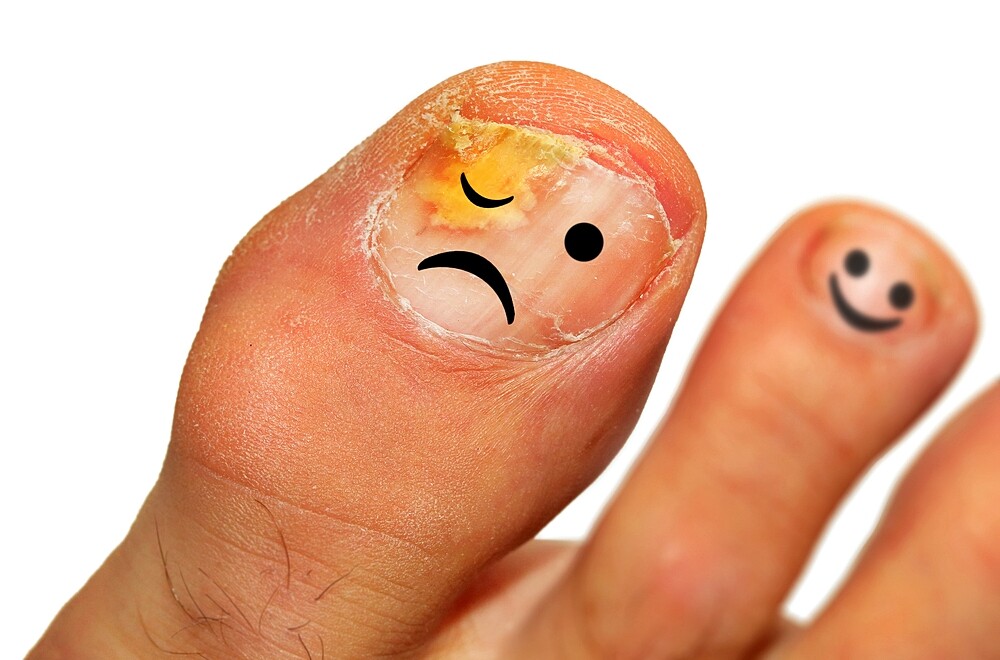Nail fungus can spread quickly and must be treated. Here we explain which home remedies can help against fungal nail fungus.
Nail fungus: What is that?
Nail mycosis (onychomycosis) is a fungal disease that can spread to toenails or fingernails. If nothing is done against the fungal infection, adjacent nails or even the skin can become infected. People who have nail fungus also run the risk of getting athlete’s foot, while athlete’s foot promotes the development of nail fungus. This is because both diseases are caused by the same pathogens (dermatophytes = filamentous fungi). A quick treatment is therefore the A & O!
Symptoms
That’s how you know fungus on nails:
- Nails are brittle, dull and lackluster
- Nail plate is thickened
- White, yellow or brownish spots appear on the nails
- Nail edges are provided with white or yellow spots
Treatment
In the treatment of nail fungus, a distinction is made between external and internal treatment and between medical and home remedies.
Medical means
- Medical varnishes: These products are only applicable if the nail growth zone is not affected. The varnish is applied to the nail and acts as an antimycotic agent (against fungal diseases) directly on the spot. The anti-fungal varnishes are available in a water-soluble and water-resistant version in pharmacies.
- Tablets: The combined treatment with tablets and varnishes is necessary if the nail growth zone is affected. The tablets act via the bloodstream and kill the nail fungus pathogens from the inside, while the varnish acts from the outside.
Home remedies
Against nail fungus several household remedies are known. Often the household remedies do not come close enough to the origin of the fungus, because they cannot penetrate sufficiently into the nail plate. Therefore their effect can only unfold to a limited extent.
If treated incorrectly, the fungus can spread quickly, so medical treatment should be the first choice. Nevertheless, household remedies can be an accompanying and supporting therapy for nail fungus. However, scientific studies on their effectiveness are still lacking.
- Vinegar: Vinegar is effective against nail fungus due to its acidity (at least 5 percent), as the fungus requires a basic or neutral environment to grow. The household remedy can be used in a footbath or as a solution for dabbing against nail fungus. For the foot bath, water (warm) and vinegar are mixed in a ratio of 1:1 and the feet are bathed in it for 10 to 15 minutes. If a foot bath is not possible, the nail can also be dabbed directly with a cotton pad or clean cloth. Apple cider vinegar has also proven to be effective in combating nail fungus. It can be applied directly or used in a foot bath with water (ratio 1:4).
- Vinegar essence: Care must be taken with the essence, as its high acid content can cause skin irritation. For a foot bath, a ratio of 1:10 with water is recommended.
- Baking powder: Baking powder can be used in various applications and is also said to be effective against nail fungus. For this purpose, the powder is either applied directly to the affected area after showering or diluted with a little water.
- Tea tree oil: Tea tree oil has an antimycotic effect and is therefore suitable as a remedy against nail fungus. To do this, apply a few drops to a cotton ball three to four times a day and dab the nail. Attention: Tea tree oil can also lead to contact eczema!
- Lemon: Lemon is also said to help as a home remedy against nail fungus. To do this, apply fresh lemon juice with the help of a cotton swab in the morning and evening and keep the procedure for several weeks.
- Medicinal plants: In phytotherapy (herbal medicine), herbal teas or foot baths made from marigold blossoms, sage leaves, turmeric root, cinnamon and rosemary leaves are recommended for the treatment of nail fungus.
- Garlic: Garlic is also said to be effective against nail fungus. The affected area is rubbed with it several times a day.
- Toothpaste: Toothpaste is also an inexpensive means, which is already available in every household. Toothpaste is regularly applied to the affected area and is said to have an antimycotic effect due to the fluorine it contains.
Here you can find more information about nail fungus.


You are doing amazing work! Thanks for sharing your wonderful post❤️. I recently had to be prescribed antibiotics for a sinus infection, so I already knew I would get a yeast infection because I always do whenever I have to take antibiotics. Diflucan gives me a lot of relief (so happy 😊 I googled ‘Nocnd247’ and got it). What many people may not know is that antibiotics can cause other medical issues to develop while taking them, such as diarrhea, nausea, stomach cramps, excessive gas, yeast infections, etc. Taking antibiotics this time resulted in me having a vaginal and anal yeast infection. I hate itching worse than being in pain!